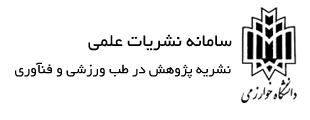دوره 23، شماره 29 - ( 4-1404 )
جلد 23 شماره 29 صفحات 198-174 |
برگشت به فهرست نسخه ها
Download citation:
BibTeX | RIS | EndNote | Medlars | ProCite | Reference Manager | RefWorks
Send citation to:



BibTeX | RIS | EndNote | Medlars | ProCite | Reference Manager | RefWorks
Send citation to:
Kavyani M, babarahimi H, Amiri M. Validity And Relieability Of Persian Version Of The Athlete Fear Avoidance Questionnaire (AFAQ). RSMT 2025; 23 (29) :174-198
URL: http://jsmt.khu.ac.ir/article-1-626-fa.html
URL: http://jsmt.khu.ac.ir/article-1-626-fa.html
کاویانی مریم، بابارحیمی هادی، امیری مهتاب. ویژگیهای روانسنجی نسخۀ فارسی پرسشنامۀ ترس-اجتناب ورزشکاران (AFAQ). پژوهش در طب ورزشی و فناوری. 1404; 23 (29) :174-198
استادیار، گروه علوم رفتاری، شناختی و فناوری ورزشی، دانشکده علوم ورزشی و تندرستی، دانشگاه شهید بهشتی تهران، ایران. ، ma_kavyani@sbu.ac.ir
چکیده: (3917 مشاهده)
مقدمه و هدف: هدف این پژوهش بررسی روایی و پایایی نسخۀ فارسی پرسشنامۀ ترس-اجتناب ورزشکار بود.
روش: 120 ورزشکار با سطوح مهارتی و رشتههای مختلف انتخاب و پرسشنامۀ ترس اجتناب ورزشکاران، فاجعهآمیزی درد، ترس از حرکت، اضطراب آسیب ورزشی را تکمیل کردند. روایی صوری انجام و از روش ترجمه، بازترجمه برای تأیید صحت ترجمۀ نسخۀ فارسی استفاده شد. از شاخص آلفای کرونباخ، تحلیل عاملی اکتشافی و تأییدی، ضریب همبستگی پیرسون و ضریب همبستگی درون طبقهای و همسانی درونی و پایایی زمانی استفاده شد.
یافتهها: نتایج نشان داد، مدل تک عاملی پرسشنامۀ اجتناب- ترس ورزشکاران برازش ضعیفی با دادهها داشت. بعد از انجام تحلیل عاملی اکتشافی و مشخصشدن سه عامل در این پرسشنامهها، مدل تحلیل عاملی تأییدی نیز برازش مناسب دادهها با این مدل را نشان داد؛ بهطوریکه شاخص سی اف ای 96/0 و شاخص تی. ال. آی 94/0 به دست آمد و نیز شاخص رمزی 05/0 و نسبت خیدو به درجه آزادی 39/1 به دست آمد.
نتیجهگیری نهایی: بنابراین نسخۀ فارسی پرسشنامۀ اجتناب- ترس ورزشکاران 3 عاملی و دربردارندۀ 10 سؤال و سه سازه فاجعهآمیزی (گویههای 1، 5، 8)، ترس از حرکت (4، 6، 7) و باورهای ترس- اجتناب (گویههای 2، 3، 9، 10) در جامعه ورزشکاران ایرانی تأیید شد.
روش: 120 ورزشکار با سطوح مهارتی و رشتههای مختلف انتخاب و پرسشنامۀ ترس اجتناب ورزشکاران، فاجعهآمیزی درد، ترس از حرکت، اضطراب آسیب ورزشی را تکمیل کردند. روایی صوری انجام و از روش ترجمه، بازترجمه برای تأیید صحت ترجمۀ نسخۀ فارسی استفاده شد. از شاخص آلفای کرونباخ، تحلیل عاملی اکتشافی و تأییدی، ضریب همبستگی پیرسون و ضریب همبستگی درون طبقهای و همسانی درونی و پایایی زمانی استفاده شد.
یافتهها: نتایج نشان داد، مدل تک عاملی پرسشنامۀ اجتناب- ترس ورزشکاران برازش ضعیفی با دادهها داشت. بعد از انجام تحلیل عاملی اکتشافی و مشخصشدن سه عامل در این پرسشنامهها، مدل تحلیل عاملی تأییدی نیز برازش مناسب دادهها با این مدل را نشان داد؛ بهطوریکه شاخص سی اف ای 96/0 و شاخص تی. ال. آی 94/0 به دست آمد و نیز شاخص رمزی 05/0 و نسبت خیدو به درجه آزادی 39/1 به دست آمد.
نتیجهگیری نهایی: بنابراین نسخۀ فارسی پرسشنامۀ اجتناب- ترس ورزشکاران 3 عاملی و دربردارندۀ 10 سؤال و سه سازه فاجعهآمیزی (گویههای 1، 5، 8)، ترس از حرکت (4، 6، 7) و باورهای ترس- اجتناب (گویههای 2، 3، 9، 10) در جامعه ورزشکاران ایرانی تأیید شد.
نوع مطالعه: پژوهشي |
موضوع مقاله:
آسیب شناسی و حرکات اصلاحی
دریافت: 1403/4/27 | پذیرش: 1403/9/1 | انتشار: 1404/4/10
دریافت: 1403/4/27 | پذیرش: 1403/9/1 | انتشار: 1404/4/10
فهرست منابع
1. Evans L, Brewer BW. Applied psychology of sport injury: Getting to-and moving across-The Valley of death. Journal of Applied Sport Psychology. 2022;34(5):1011-28.
https://doi.org/10.1080/10413200.2021.2015480 [DOI:10.1080/10413200.2021.2015480.]
2. Cassidy Rex C, Metzler JN. Development of the Sport Injury Anxiety Scale. Measurement in Physical Education and Exercise Science. 2016;20(3):146-58.
https://doi.org/10.1080/1091367X.2016.1188818 [DOI:10.1080/1091367X.2016.1188818.]
3. Gorji SM, Mohammadi Nia Samakosh H, Watt P, Henrique Marchetti P, Oliveira R. Pain Neuroscience Education and Motor Control Exercises versus Core Stability Exercises on Pain, Disability, and Balance in Women with Chronic Low Back Pain. International Journal of Environmental Research and Public Health. 2022;19(5):2694.
https://doi.org/10.3390/ijerph19052694 [DOI:10.3390/ijerph19052694.]
4. Kvist J, Ek A, Sporrstedt K, Good L. Fear of re-injury: a hindrance for returning to sports after anterior cruciate ligament reconstruction. Knee Surg Sports Traumatol Arthrosc. 2005;13(5):393-7.
https://doi.org/10.1007/s00167-004-0591-8 [DOI:10.1007/s00167-004-0591-8.]
5. Vlaeyen JW, Linton SJ. Fear-avoidance and its consequences in chronic musculoskeletal pain: a state of the art. Pain. 2000;85(3):317-32.
https://doi.org/10.1016/S0304-3959(99)00242-0 [DOI:10.1016/S0304-3959(99)00242-0.]
6. Vlaeyen JW, Linton SJ. Fear-avoidance model of chronic musculoskeletal pain: 12 years on. Pain. 2012;153 1147(6).
https://doi.org/10.1016/j.pain.2011.12.009 [DOI:10.1016/j.pain.2011.12.009.]
7. Lethem J, Slade PD, Troup JD, Bentley G. Outline of a Fear-Avoidance Model of exaggerated pain perception--I. Behav Res Ther. 1983;21(4):401-8.
https://doi.org/10.1016/0005-7967(83)90009-8 [DOI:10.1016/0005-7967(83)90009-8.]
8. Sullivan MJ, Tripp DA, Rodgers WM, Stanish W. Catastrophizing and pain perception in sport participants. Journal of Applied Sport Psychology. 2000;12(2):151-67.
https://doi.org/10.1080/10413200008404220 [DOI:10.1080/10413200008404220.]
9. Podlog L, Dimmock J, Miller J. A review of return to sport concerns following injury rehabilitation: practitioner strategies for enhancing recovery outcomes. Phys Ther Sport. 2011;12(1):36-42.
https://doi.org/10.1016/j.ptsp.2010.07.005 [DOI:10.1016/j.ptsp.2010.07.005.]
10. Arvinen-Barrow M, Massey WV, Hemmings B. Role of Sport Medicine Professionals in Addressing Psychosocial Aspects of Sport-Injury Rehabilitation: Professional Athletes' Views. Journal of Athletic Training. 2013;49(6):764-72.
https://doi.org/10.4085/1062-6050-49.3.44 [DOI:10.4085/1062-6050-49.3.44.]
11. Hambleton R, Sireci S, Robin F. Adapting credentialing exams for use in multiple languages. CLEAR Exam Review. 1999;10(2):24-8.
https://doi.org/10.1108/13522750310495328 [DOI:10.1108/13522750310495328.]
12. Tenenbaum G, Kamata A, Hayashi K. Measurement in sport and exercise psychology: A new outlook on selected issues of reliability and validity. Handbook of sport psychology. 2007:757 -73.
https://doi.org/10.1002/9781118270011 [DOI:10.1002/9781118270011.]
13. Piermattéo A, Lo Monaco G, Reymond G, Eyraud M, Dany L. The meaning of sport and performance among amateur and professional athletes. International Journal of Sport and Exercise Psychology. 2020;18(4):472-84.
https://doi.org/10.1080/1612197X.2018.1536160 [DOI:10.1080/1612197X.2018.1536160.]
14. Kline RB. Principles and practice of structural equation modeling: Guilford publications; 2023. https://www.guilford.com/books/Principles-and-Practice-of-Structural-Equation-Modeling/Rex-Kline/9781462551910
15. Terry PC, Lane AM, Fogarty GJ. Construct validity of the Profile of Mood States - Adolescents for use with adults. Psychology of Sport and Exercise. 2003;4(2):125-39.
https://doi.org/10.1016/S1469-0292(01)00035-8 [DOI:10.1016/S1469-0292(01)00035-8.]
16. Dover G, Amar V. Development and validation of the athlete fear avoidance questionnaire. Journal of athletic training. 2015;50(6):634-42. [DOI:10.4085/1062-6050-49.3.75]
17. Sullivan MJ, Bishop SR, Pivik J. The pain catastrophizing scale: development and validation. Psychological assessment. 1995;7(4):524.
https://doi.org/10.1037/1040-3590.7.4.524 [DOI:10.1037/1040-3590.7.4.524.]
18. Rahmati N, Asghari Moghadam MA, SHAIRI M, Paknejad M, Rahmati Z, Ghassami m, et al. A Study of the Psychometric Properties of the Pain Catastrophizing Scale Amongst Iranian Patients with Chronic Persistent Pain. Journal title. 2017;25(1):63-79.
https://doi.org/10.29252/sjimu.25.1.63 [DOI:10.29252/sjimu.25.1.63.]
19. Kortlever JTP, Tripathi S, Ring D, McDonald J, Smoot B, Laverty D. Tampa Scale for Kinesiophobia Short Form and Lower Extremity Specific Limitations. Arch Bone Jt Surg. 2020;8(5):581-8. [DOI:10.22038/abjs.2020.40004.2073.]
20. French DJ, France CR, Vigneau F, French JA, Evans RT. Fear of movement/(re) injury in chronic pain: a psychometric assessment of the original English version of the Tampa scale for kinesiophobia (TSK). Pain. 2007;127(1-2):42-51.
https://doi.org/10.1016/j.pain.2006.07.016 [DOI:10.1016/j.pain.2006.07.016.]
21. Woby SR, Roach NK, Urmston M, Watson PJ. Psychometric properties of the TSK-11: a shortened version of the Tampa Scale for Kinesiophobia. Pain. 2005;117(1-2):137-44.
https://doi.org/10.1016/j.pain.2005.05.029 [DOI:10.1016/j.pain.2005.05.029.]
22. Saadat M, Salamat S, Mostafaee N, Soleimani F, Rouintan Z, Amin M. To evaluate responsiveness and minimal important change (MIC) for the Persian versions of FABQ, TSK, and PCS. European Spine Journal. 2023;32(9):3023-9.
https://doi.org/10.1007/s00586-023-07835-w [DOI:10.1007/s00586-023-07835-w.]
23. Cassidy CM. Development of a measure of sport injury anxiety: The Sport Injury Appraisal Scale. 2006.
https://doi.org/10.1080/1091367X.2016.1188818 [DOI:10.1080/1091367X.2016.1188818.]
24. Gahvare R, Rajabi R, Shahrbanian S, Gharayagh Zandi H, Hosseini SM. Investigation of Validity and Reliability of Revised Persian Version of Sport Injury Anxiety Scale (PSIAS). Middle Eastern Journal of Disability Studies. 2018;8(0):47-. https://dor.isc.ac/dor/20.1001.1.23222840.1397.8.0.74.9
25. Melzack R, Wall PD. Handbook of pain management: Elsevier; 2003. [DOI:10.1093/bja/aeh541]
26. Melzack R. From the gate to the neuromatrix. Pain. 1999;82:S121-S6.
https://doi.org/10.1016/S0304-3959(99)00145-1 [DOI:10.1016/S0304-3959(99)00145-1.]
27. Lee JW-Y, Mok K-M, Chan HC-K, Yung PS-H, Chan K-M. A prospective epidemiological study of injury incidence and injury patterns in a Hong Kong male professional football league during the competitive season. Asia-Pacific Journal of Sports Medicine, Arthroscopy, Rehabilitation and Technology. 2014;1(4):119-25.
https://doi.org/10.1016/j.asmart.2014.08.002 [DOI:10.1016/j.asmart.2014.08.002.]
28. Hu Lt, Bentler PM. Cutoff criteria for fit indexes in covariance structure analysis: Conventional criteria versus new alternatives. Structural equation modeling: a multidisciplinary journal. 1999;6(1):1-55. [DOI:10.1080/10705519909540118]
29. Creswell JW, Miller DL. Determining validity in qualitative inquiry. Theory into practice. 2000;39(3):124-30.
https://doi.org/10.1207/s15430421tip3903_2 [DOI:10.1207/s15430421tip3903_2.]
30. Kelloway EK. Using LISREL for structural equation modeling: A researcher's guide: Sage; 1998. [DOI:10.1002/job.4030160304]
31. dos Reis-Junior JR, Bassi-Dibai D, Morais DN, Pontes-Silva A, Mendes LP, Pinheiro JS, et al. Translation, cross-cultural adaptation, and validation of the Athlete Fear Avoidance Questionnaire (AFAQ) into Brazilian Portuguese. BMC Musculoskeletal Disorders. 2022;23(1):974.
https://doi.org/10.1186/s12891-022-05951-0 [DOI:10.1186/s12891-022-05951-0.]
32. Monticone M, Dover G, Massidda M, Giordano A, Franchignoni F. Cross-cultural adaptation and validation of the Athlete Fear Avoidance Questionnaire in Italian university athletes with musculoskeletal injuries. International Journal of Rehabilitation Research. 2022;45(3):223-9. [DOI:10.1097/MRR.0000000000000532]
33. O'Keeffe S, Chéilleachair NN, O'Connor S. Fear avoidance following musculoskeletal injury in male adolescent gaelic footballers. Journal of sport rehabilitation. 2019;29(4):413-9.
https://doi.org/10.1123/jsr.2018-0258 [DOI:10.1123/jsr.2018-0258.]
34. Fukano M, Mineta S, Hirose N. Fear avoidance beliefs in college athletes with a history of ankle sprain. International journal of sports medicine. 2020;41(02):128-33.
https://doi.org/10.1055/a-1065-1940 [DOI:10.1055/a-1065-1940.]
35. Fischerauer SF, Talaei-Khoei M, Bexkens R, Ring DC, Oh LS, Vranceanu A-M. What is the relationship of fear avoidance to physical function and pain intensity in injured athletes? Clinical orthopaedics and related research. 2018;476(4):754. [DOI:10.1007/s11999.0000000000000085]
ارسال پیام به نویسنده مسئول
| بازنشر اطلاعات | |
 |
این مقاله تحت شرایط Creative Commons Attribution-NonCommercial 4.0 International License قابل بازنشر است. |






